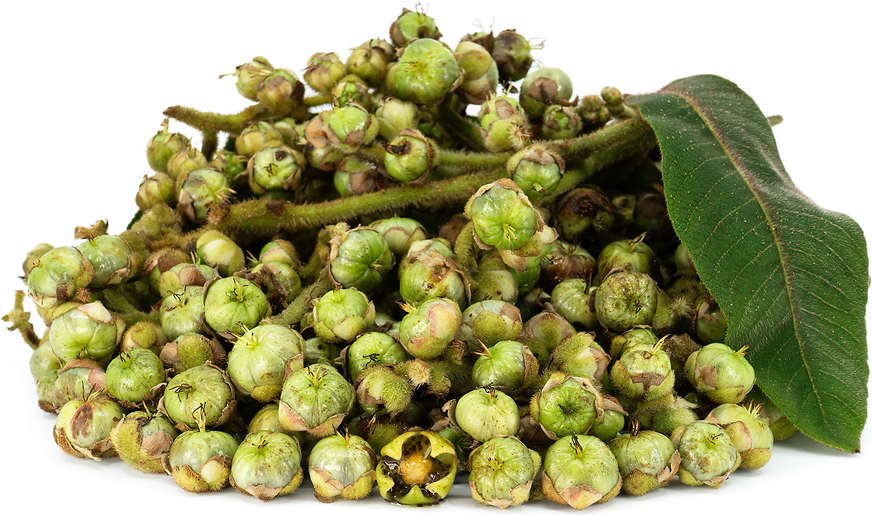


Dulumoco Fruit
Estimated Inventory, lb : 0
Description/Taste
Dulumoco is small in size, averaging 0.5 to 1.5 centimeters in diameter, and has a round, elliptical to subglobose shape with curved edges. The fruits characteristically have sepals that remain attached around the base and a few hair-like strands that protrude from the center, thin remnants of the flower’s stamens. Dulumoco is green when unripe, transitioning to white-green and pale red shades when mature. The color change is not drastic, and maturity is determined by size and flesh consistency. The fruit’s surface is taut, thin, and delicate, being easily opened by hand or teeth. The fruit’s exterior can also be separated into 4 to 5 sections, revealing a soft, mucilaginous interior. The fruit’s flesh is comprised of a clear, sticky, and slimy gel-like liquid that encases many tiny black seeds. When the fruits are unripe, they will have less liquid, and the seeds will be white. Select Dulumoco fruit that is large and swollen in size, almost appearing like they are about to burst. Partially ripe Dulumoco fruits will have a sweet and sour taste. The preferred stage is maturity, when the fruits have a neutral and sweet flavor.
Seasons/Availability
Dulumoco fruit is typically in season around Easter, between March and April. Some species also produce fruits from October to November or at other points throughout the year, depending on the climate, variety, and growing region.
Current Facts
Dulumoco, botanically a part of the Saurauia genus, is a category of similar fruiting species belonging to the Actinidiaceae family. The small fruits grow on trees reaching 10 to 15 meters in height and form compact clusters. Dulumoco is the Colombian name for the fruits, and it is important to note that many regional names are used throughout the Americas. Other common names include Moquillo, Moco, Chup, Aguanoso, Cargagua, Lulumoco, Pucachino, Chupahuevos, Moco de Jesus, Maxbal, Cargagua, and Churimo. The Saurauia genus is estimated to encompass approximately 300 species, and it is undefined how many of these species produce edible fruits. Research and discussion with a professional forager should be conducted before harvesting wild fruit. In its native growing regions in Central and South America, communities have gathered ripe fruits throughout history as a sweet snack. Ripe Dulumoco fruits fall to the ground, and more can be shaken from the trees. The fruiting process can take anywhere from 1 to 6 months, depending on the species and growing conditions, and many of the fruit’s common names allude to its distinctly sticky, mucilaginous texture. Dulumoco fruit is not commercially cultivated and has remained a mostly wild species. Ripe fruits are enjoyed fresh as a snack and are known for their texture and taste.
Nutritional Value
Dulumoco fruit has not been extensively studied for its nutritional properties. Each species varies in vitamin and mineral content, and the fruits have remained a relatively wild species, being foraged and not used for commercial purposes. One research paper titled “Especies útiles en la Región Andina de Colombia,” by the Jardin Botanico de Bogota, mentions that Saurauia scabra contains small amounts of calcium, phosphorus, magnesium, copper, iron, and zinc. Saurauia scabra is just one of many species collectively called Dulumoco. Calcium and phosphorus support bone and teeth health, while magnesium helps the body control nerve functions. Copper assists in producing red blood cells, iron develops the protein hemoglobin for oxygen transport through the bloodstream, and zinc promotes overall bodily health by strengthening the immune system.
Applications
Dulumoco fruit has a sweet taste suited for fresh consumption. Each fruit ripens at a different time, and if possible, mature types should be harvested individually to be consumed immediately. Dulumoco fruit is preferred ripe, and the mucilaginous flesh and seeds are sucked directly from the fruit. The fruits are a popular foraged crop among children in Central and South America and are favored for their sweet, honey-like nature. Dulumoco fruit is also occasionally simmered into jams, jellies, and other preserves, especially by older generations. While less common, some communities in the Americas extract the liquid and mix it with water to make various beverages. The liquid is also fermented into wine and vinegar. Dulumoco fruit has a short shelf life and should be immediately consumed after harvest for the best quality and flavor.
Ethnic/Cultural Info
Trees within the Saurauia genus are becoming vulnerable in Central and South America due to habitat loss and their use as construction materials. The wood is sometimes used to build fences, posts, and furniture. Knowledge surrounding the fruit’s edibility is declining and disappearing among younger generations, resulting in the trees being removed without replanting. Despite these dangers, some communities plant the trees in urban parks, home gardens, and along pathways in an effort to preserve the species. Fruits from Saurauia trees provide a natural food for many birds, contributing to local diversity and ecological restoration.
Geography/History
Dulumoco is a general descriptor for several similar-looking fruits belonging to various species within the Saurauia genus. These species are native to a broad region spanning from Mexico to Colombia in the Americas and have been growing wild since ancient times. Saurauia species thrive in humid, tropical to subtropical climates and are naturally found in forests, grasslands, woodlands, and along riverbanks, typically between 500 and 3,000 meters in elevation. Species have also been planted as an ornamental in various parks, along sidewalks, trails, and in other urban landscapes. Today, Dulumoco fruit is primarily a foraged crop from wild and home garden trees. During peak season, the fruits are occasionally found at local markets in their growing regions. The Dulumoco fruit featured in the photograph above was sourced through a market in Colombia.




